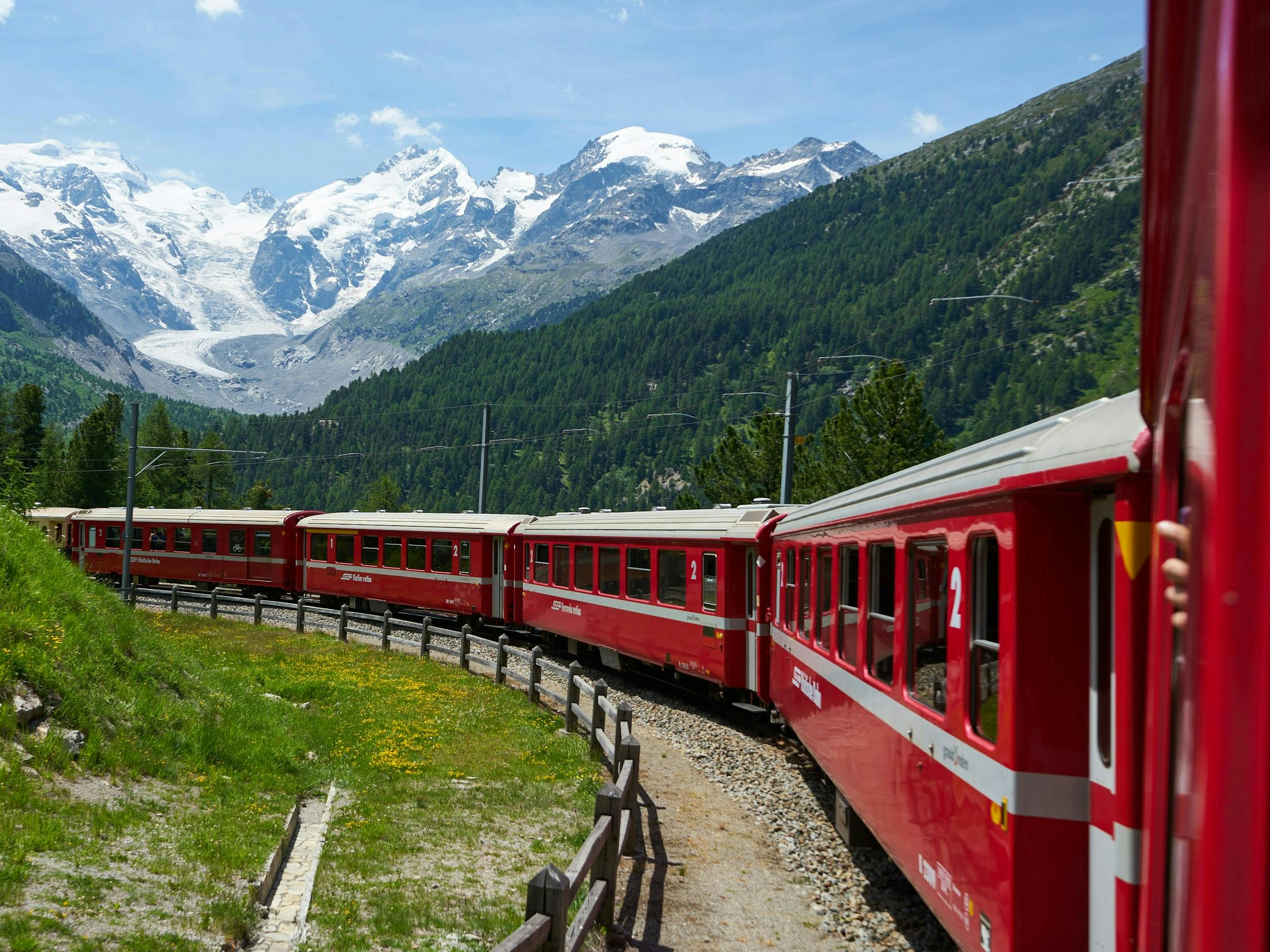The Rhaetian Railway: the Bernina route
Lukas Seitz
The Bernina route on the Rhaetian Railway isn’t just a way to get from A to B; it’s a journey through the heart of the Alps and a feat of engineering brilliance. The Rhaetian Railway comprises nine lines, including the UNESCO World Heritage-listed Albula line (from Chur to St. Moritz) and the Bernina line (from St. Moritz to Tirano), which form the Bernina route. Completed in the early 20th century, these lines were designed to connect remote Alpine communities, weaving through some of Switzerland’s most dramatic mountain landscapes, crossing viaducts, spiralling through tunnels and climbing seemingly impossible gradients.
The route is served by two train services that run across both lines:
The Bernina Express: a service designed for tourists with panoramic carriages, which runs the length of both lines twice a day in summer (once in winter).
Regional trains: services designed for tourists and locals alike, running hourly throughout the year with some open-air carriage services in summer.
So, which one should you take for your journey across this heritage railway?
Becca McCowan
The Bernina route: train services
The Bernina Express
The most well-known service, the Bernina Express offers panoramic carriages with uninterrupted views of the scenery through oversized windows stretching up to the ceiling. The journey takes around 4 hours, covering 144 kilometres of tracks. It’s designed for comfort, with first and second-class seating, an audio guide in multiple languages, and a refreshment trolley (there’s no dining car).
However, it’s an experience designed for tourists with limited stops at key stations. You can alight along the way, but you’ll have to take a local train for the rest of your journey (or buy another reservation for the next Bernina Express service). Tickets are on the pricier side (starting at CHF 96 for second class regular ticket, and CHF 164 one way), and reservations are mandatory (starting from CHF 32). You can travel on the Bernina Express with an Interrail/Eurail pass, but will still need a reservation (read our blog about Interrail/Eurail for more information about passes).
Undeniably impressive, the Bernina Express’s panoramic windows, premium feel and lack of stops make it a great choice for some travellers.
The local train
For those who want to experience the Alps on their own terms with fewer tourists and more freedom, the local train is the way to go. It runs the same route as the Bernina Express, but with frequent stops at small stations along the way and you’ll need to change trains at St. Moritz. The journey takes slightly longer, at 4.5 hours, but this extra time is an opportunity.
With no reservation required, you can hop on and off wherever you like, giving you more flexibility and freedom to discover lesser-discovered stops along the way. Fancy a lunch break (or overnight stay) at the Alp Grüm Hotel, perched at 2091m high and only accessible by foot or train? Want to stretch your legs at the Morteratsch Glacier trailhead (depending on the weather)? Feel like wandering through the Alpine town of Poschiavo? You can.
Tickets are affordable (CHF 30–40 one way), and if you have an Interrail/Eurail or Swiss Travel Pass, it’s completely free. In summer, some services have open-air carriages that let you soak up the Alpine air, while winter brings cosy, heated carriages perfect for snowy landscapes. On some local trains, you can open the window year-round, avoiding pesky reflections in your pictures (something you can’t do on the Bernina Express).
The local train also supports the communities along the route, giving you a chance to connect with the region rather than just passing through. It’s quieter, less crowded, and perfect for travellers who value flexibility and spontaneity.
Zacharie Grossen
The Bernina route: journey walkthrough
If you’re starting in Switzerland, you’ll begin your journey in Chur, Switzerland’s oldest city. Inhabited since 3000 BC, the city sits at the meeting point of the Plessur and Rhine rivers and is surrounded by mountains. The car-free Altstadt (old town) is home to buildings with painted façades, winding streets and traditional Swiss restaurants like Restaurant Drei Bünde, while the Brambrüesch cable-car whisks you from the city centre to a high plateau with views over the valley.
The train departs from Chur main station along the Albula Line, following the course of the Rhine to Bonaduz, then entering the Domleschg Valley and climbing steadily into the mountains to Thusis and Tiefencastel.
After Tiefencastel, you’ll pass over the Landwasser Viaduct, where the train floats above the valley, before spiralling through tunnels between Filisur and Bever, that showcase the ingenuity of early 20th-century railway builders.
Pascal Debrunner
The train continues to Samedan and St. Moritz, a glamorous Alpine resort and a skiing hub. You’ll need to change trains here if you’re on the local train, giving you time to pause if you wish. After St. Moritz, you’ll travel to Pontresina, in the Bernina Valley, a gateway to hiking trails and the Morteratsch Glacier.
From Pontresina, you’ll travel along the Bernina Line to the famed Bernina Pass, where the train skirts glacial lakes and rugged peaks. At over 2,253m, you’ll reach the highest point of the journey and Ospizio Bernina with its station café. Next up is Alp Grüm, sitting on a ridge of the Bernina Pass and offering a postcard-perfect stop for lunch with views of the Palü Glacier.
Cat Jones
After Alp Grüm, you’ll loop through valleys and past villages to Poschiavo, an Italian-speaking town. Wander its piazzas or grab an artisan gelato at Bio-Bistro Semadeni before continuing your descent past the pretty Poschiavo Lake.
Finally, you’ll arrive in the town of Tirano, where palm trees and Mediterranean warmth offer a stark contrast to the Alpine peaks you’ll have travelled through. Here, you can linger for a while and enjoy the regional buckwheat pasta dish, pizzocheri (served with potato, cabbage and cheese), connect to Milan, Lake Como and other Italian destinations, or head back the way you came.
